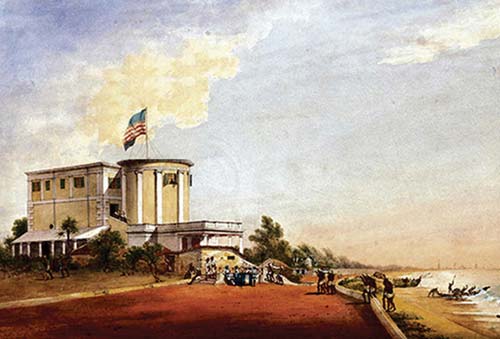Registered with the Registrar of Newspapers for India under R.N.I 53640/91
Vol. XXVII No. 2, May 1-15, 2017
Lost landmarks of Chennai
- Sriram V

Ice House – in its earliest days when the Tudors occupied it.
The Syrian roof of the Ice House
The Ice House is a familiar, and, happily for us, living landmark of the city. Constructed in 1838 as a storehouse for the ice being imported from the Tudor Ice Company of the United States, it later became a residence in which capacity it played host to Swami Vivekananda in the 1890s. It has forever been associated with his name. Forgotten now is the fact that the building also played an important role from 1917 to 1922 in the widows’ rehabilitation movement begun by Sister Subbalakshmi. It later became a hostel for the B.Ed. course students and in 1963 was named Vivekanandar Illam. In 1997, the Government gave the building on lease to the Ramakrishna Math, for a permanent exhibition on Swami Vivekananda. This lease was extended to 99 years in 2012.
What is forgotten is that the construction of this building was in its time considered path breaking. The storage of ice meant that the structure could not use timber, as it would rot in the prevalent moisture. It was left to the architect Maj. (later Col.) J.J. Underwood of the Madras Engineers to come up with an ingenious solution. He decided to borrow from the techniques used in Syria where domed structures were built without using timber.
Earthenware cylinders, each of around nine inches length, but of tapering diameter, the wider end varying from 5 to 6″ and the narrower end 3 to 3½” were made on potter’s wheels. The walls were built to their full height and work on the dome began. This was raised with lime mortar to a height of 3 to 3½” with support from a bamboo scaffolding and then the cylinders were laid in a circle, embedding them firmly in the chunam/lime. The next circle rested in the gaps between the cylinders of the first curve and so on till the top was reached and this was sealed with one cylinder being forced into the orifice. Liquid chunam was spread on the cylinders and, on this, two rows of flat chunam tiles were placed. Polished chunam was then spread on top of this, thereby completing the first parabolic dome in Madras. The scaffolding was dismantled after time was given for the roof to settle.

It was so sturdy that a dome of 32 feet span was constructed at the Madras Medical School (now College) by Underwood, with excellent results. It is not certain if that structure still stands. The Syrian roof perfected by Underwood was written eulogistically about by Capt. George Underwood (probably a kinsman) and included in an 1838 issue of the Madras Journal of Literature and Science brought out by the Madras Literary Society. It notes that this kind of roof cost half what a traditional Madras terrace did and had the advantage of being proof to vermin and termites. The article also recorded as to how white ants had recently eaten into the organ loft of the St. Mary’s Church, necessitating its replacement. A similar problem had broken out at St. George’s Cathedral where the teak supports of the organ gallery had been eaten up and, later, the sounding board of the pulpit too gave way. Such problems, it noted, could never happen with a Syrian roof. Strangely enough, despite all these proffered advantages, it was the Madras terrace that proved popular, lasting well into the 1950s as the preferred style. It is not clear if the Syrian roof at the Ice House still stands or whether it was done away with in subsequent restorations. If it is still around, it could make for an interesting study, rather like the terracotta wells that Maj. Thomas Fiott de Havilland used for building the foundations of the St. Andrew’s Kirk.
Underwood was constructing two buildings at the same time on the beachfront. The Masonic Temple of the Lodge Perfect Unanimity was coming up under his supervision and was completed along with Ice House. That building, now better known as the Directorate General of Police headquarters, has survived too. The Lodge PU, though happy with the design, felt the location was too remote and opted to move to Mount Road, eventually selling its temple on the beach to the police who have been in occupation now for 150 years and more. And like Ice House it is also well cared for, though a purist may shudder at the manner in which the restoration has been done in both buildings.
It is indeed a miracle that two of Underwood’s constructions are still standing and well cared for. Not many of his successors, such as Chisholm, Irwin or Stephen have had that kind of luck.

